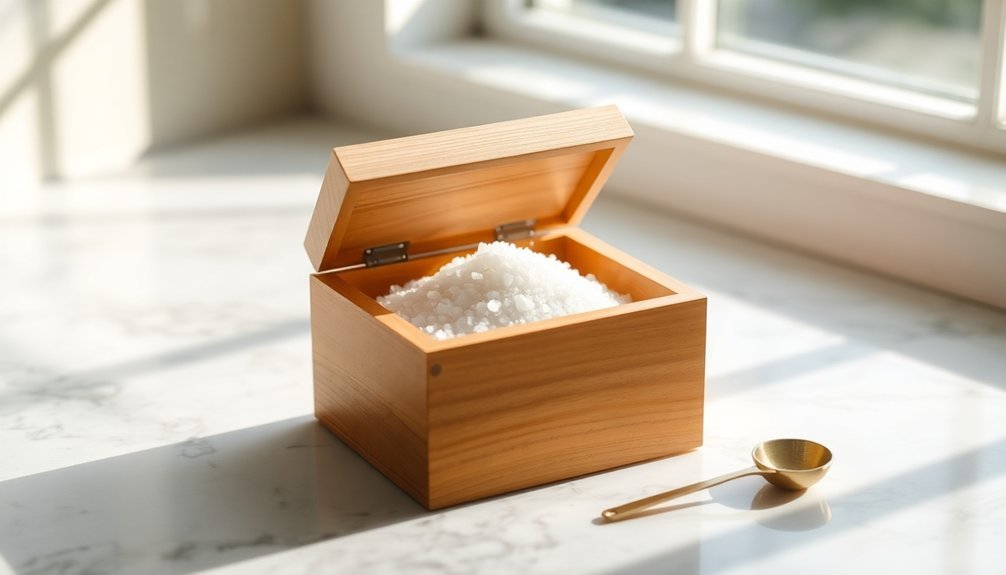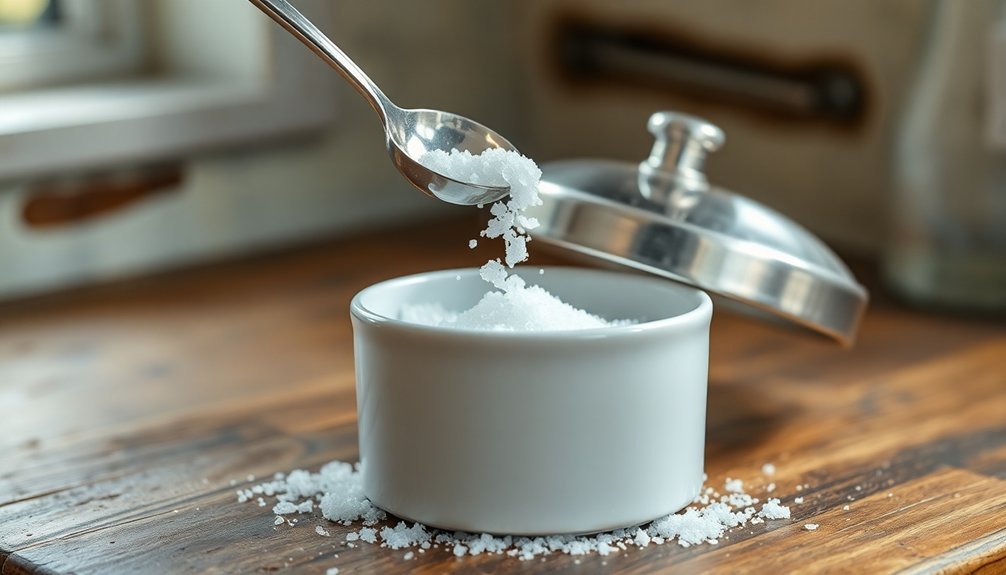When building a salt box for food storage, you'll want to focus on three key elements for the best results. First, select hardwoods like white oak or olive wood, as they're naturally resistant to moisture and won't affect your salt's taste. Second, verify your box dimensions allow for proper capacity – aim for a height between 2.3 to 3.5 inches and a diameter of 3.4 to 4.9 inches for ideal storage. Third, incorporate a flip-top or swivel lid design to keep moisture out while maintaining easy access to your salt. These fundamentals will set you up for success, but there's much more to creating the perfect salt storage solution.
Building Your Salt Box

Before diving into construction, you'll need to gather the right materials and tools for your salt box project. White oak is an excellent hardwood choice, and you'll require essential tools like a plunge router, guide bushing, tablesaw, dado stack, and box joint jig.
Don't forget your thicknesser, jointer, sander, and drill press for precise woodworking. The project should take approximately 26 minutes to complete when working with standard material thickness.
Start by cutting your stock to the recommended dimensions: 3.375" wide and 3/8" thick, with varying lengths for different sides. Use your tablesaw to rip the pieces and the thicknesser to guarantee uniform thickness throughout.
When you're ready for assembly, create box joints using your jig for sturdy construction. Set up your router to create any necessary holes and edges, paying special attention to the lid design.
You'll want a flip-top style that opens easily while keeping moisture out. If you're building a dual-chambered version, carefully plan your divider placement. Assemble the pieces using appropriate wood glue and fasteners, then finish with mineral oil for protection.
Test the lid's fit and movement before considering any decorative brass elements.
Choosing The Right Wood
Now that you've planned your salt box construction, selecting the right wood type will determine your project's longevity and appearance. For maximum durability, you'll want to take into account hardwoods like olive wood, quartersawn white oak, or black walnut. These woods resist wear and will maintain their integrity with daily use in your kitchen.
Your aesthetic preferences can guide your wood selection as well. If you're looking for a striking, natural appearance, olive wood's variegated patterns make an excellent choice. Italian craftsmen specifically source their olive wood for its premium grain patterns. For a more traditional look, cherry and black walnut offer rich, dark tones that'll enhance your kitchen's decor.
If you prefer lighter tones, white oak or pine can provide classic grain patterns. When choosing your wood, make sure it hasn't been treated with harmful chemicals. You'll need to pair your wood choice with food-safe finishes like shellac for the interior, or beeswax and mineral oil for both inside and outside surfaces.
For added personalization, you can combine different woods to create unique patterns or add woodburned designs. If you're using douglas fir, opt for clear vertical grain to guarantee stability and longevity.
Essential Box Measurements

Getting the measurements right stands at the heart of a successful salt box project. When you're selecting your salt box, you'll find most standard options range from 3.4 to 4.9 inches in diameter, with heights typically between 2.3 to 3.5 inches. These dimensions guarantee practical countertop storage while maintaining easy access to your seasonings.
For capacity planning, you'll want to take into account how much salt you regularly use. Standard boxes hold between 65 to 303 grams, with most falling in the middle range of 129 to 187 grams. The Olive Wood Salt Box offers a practical 4-ounce capacity that's suitable for most household needs, while the ZEROJAPAN model provides the largest capacity at 303 grams. The eco-friendly materials used in these boxes ensure sustainability without compromising functionality.
You'll need to factor in lid clearance when measuring your available space. Swivel-top and flip-top designs require additional overhead room for operation.
If you're working with limited space, think about compact options like the Totally Bamboo Salt Cellar at 3.5 x 2.75 inches. For easier refills and cleaning, boxes with removable lids need vertical clearance equal to their full height plus the lid thickness.
Frequently Asked Questions
How Long Can Preserved Food Remain Safe in a Salt Box?
You can safely preserve food in a salt box for 3-6 months when properly sealed and stored in a cool, dry place. Don't forget to check periodically for any signs of spoilage or moisture.
Can I Reuse Salt From a Salt Box After Preserving Food?
You can reuse salt after preserving food since it doesn't lose its preservative properties. While it might clump or absorb odors, it's still safe to use. Just store it properly in an airtight container.
What Signs Indicate the Salt in My Box Needs Replacement?
You'll need to replace your salt if you notice insects, mold, unusual odors, discoloration, hard clumps, or moisture absorption. If it's absorbed strong smells from nearby foods, it's also time for fresh salt.
Should I Pre-Treat My Salt Box With Mineral Oil?
You don't need to pre-treat your salt box with mineral oil. The natural materials commonly used, like wood, bamboo, or ceramic, work well without it. Just keep your box clean and dry for best results.
How Often Should I Clean My Salt Box Between Different Food Items?
You'll need to clean your salt box after handling raw meat, poultry, or seafood, and when switching between raw and ready-to-eat foods. Also, clean it after any interruption that may cause contamination.
In Summary
You'll find that building a salt box is a straightforward project that'll enhance your kitchen storage. With the right wood selection and precise measurements, you've got all you need to create a functional piece. Keep these tips in mind, and you're ready to construct a durable salt box that'll serve you well for years of cooking and food preservation.





Leave a Reply